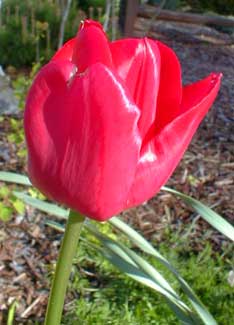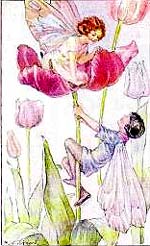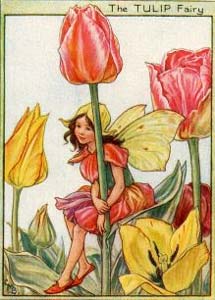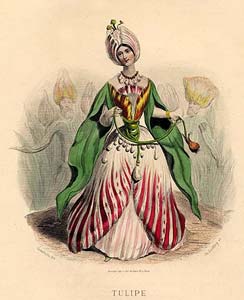
'Couleur Cardinal' Tulip,
& the Tulip Fairies
"Our stalks are very straight & tall,
Our colours clear & bright;
Too many-hued to name them all --
Red, yellow, pink, or white.
And some are splashed, & some, maybe,
As dark as any plum.
From tulip-fields across the sea
To England did we come.
We were a peaceful country's pride,
And Holland is its name.
Now in your gardens we abide --
And aren't you glad we came?"
-Cicely Mary Barker's Tulip-fairy Song
Single Early tulips have mid-height sturdy stems usually only about one-foot tall & not at all tippy. The egg-shaped flowers can be had in numerous intense colors, including bright red varieties among which 'Couleur Cardinal' is one of the standards suitable for zones 3 through 8.
They look good in drifts of many of a single color, or popping up singly here & there amidst sundry sun-garden perennials. They bloom early enough that many taller perennials will not yet have reached their late-spring height, so that early single tulips can be scattered amidst echinaceas, sages, & other summer perennials, so that flowers will be numerous above the foliage of surrounding plants that will be tall & flowering after the tulips are finished for the year.
Single-early tulips bloom after kaufmanniana waterlily tulips & fosteriana tulips (such as Emperors), or at the same time as many greigii tulips, but before most hybrid tulips. A few of them are mildly scented, including the intense red 'Couleur Cardinal' although the standard red 'Brilliant Star' is scentless.
Single early tulips hold up to wind & rain extremely well & can be very long-lasting from late March to all of April. They are among the easiest tulips to grow in containers, being very forgiving of their conditions. The bulbs can perennialize for many years without needing to be lifted.
 Although tulips come in all colors, it is red that first comes to mind as the most fundamental tulip color. One sees it in poetry which speaks of red tulips, in fairy illustrations wherein tulip-fairies are generally red, & in all sorts of folk art.
Although tulips come in all colors, it is red that first comes to mind as the most fundamental tulip color. One sees it in poetry which speaks of red tulips, in fairy illustrations wherein tulip-fairies are generally red, & in all sorts of folk art.This is perhaps because yellow is identified with daffodils & white with Madonna lilies & blue with English bluebells, so that red falls to the tulip as quintessential; whatever the reason, red is the literary ideal whether in writings of Arabia & Persia, or in Europe & North America.
In Islamic symbolism the ideal tulip is lily-flowering with recurved petals, & preferrably red, because this is indicative of the soul's fiery desire for God, or it is because the first tulips were said to have arisen from the blood of the martyred Hussein, son of the Prophet. In the west the "basic" tulip is egg-shaped rather than with recurved petals, but the idealized color is still red.
At first blush (to attempt a pun) the western symbolism of the red tulip is not nearly as infused with Divine meaning as it is for Islam. But it could well be that the egg-shape preferred in the west did does evoke subliminal cultural memories of the age of the Earthmother, among whose symbols was the fertile egg.
 Or, if that is too farfetched, the Victorian language of flowers, which borrowed from Near & Far East mythology, made red tulips the symbol of perfect & irresistible Love, but not necessarily of an erotic kind, that being symbolized by a red rose.
Or, if that is too farfetched, the Victorian language of flowers, which borrowed from Near & Far East mythology, made red tulips the symbol of perfect & irresistible Love, but not necessarily of an erotic kind, that being symbolized by a red rose.This fundamentally pure love is not all that different from the Persian sense that the tulip evoked the soul's eager burning for God. By contrast, yellow tulips in the Language of Flowers indicated hopeless, spurned, or unachievable Love.
But it is in the Tulip Fairy that the supernatural nature of this flower found its last lingering mythological expression for the west. The idea of a Tulip Fairy has found its way into art, poetry, & commerce. If someone lost their mind & wanted to fill their home with Tulip Fairy kitsch, they would be able to find a half-dozen cross-stitch patterns & kits based on art nouveau & Victorian designs, & cross stitch themselves big wall-hangings of tulip-fairies or pillows.
And they could obtain old christmas ornaments in the shape of cherubic-faced fairies issuing from out of tulips -- not to mention a whole array of ornaments based on Cicely Mary Barker flower-fairies & imitations thereof.
Then there's a wide array of tulip-fairy three-dimensional wall plaques, cut crystal, or little figurines of glass, pottery, or pewter. There's a pewter ring studded with semi-precious stones, the main feature being a tulip fairy. There's an end-table lamp or bedlamp with glass base showing a tulip fairy, & more tulip fairies on the lampshade.
 There are lovely tulip-fairy stencils so that anything one owns that doesn't come ready-made with tulip fairies all over it can have them added for the sake of a wondrously loony household theme. And one simply must possess in decorative frame the Flower Fairy commemorative coin from the Isle of Mann.
There are lovely tulip-fairy stencils so that anything one owns that doesn't come ready-made with tulip fairies all over it can have them added for the sake of a wondrously loony household theme. And one simply must possess in decorative frame the Flower Fairy commemorative coin from the Isle of Mann.There are tulip fairy greeting cards & stationary sets & bookmarks & posters & candles, & plastic-headed tulip-fairy dolls so grotesquely cute they're horrifying.
There's a tulip fairy jigsaw puzzle, & a tulip-fairy toiletry set with tulip-fairy hairbrush & perfume or body-wash allegedly smelling of tulips so that you, too, can smell like a tulip fairy, without reference to the fact that tulips generally have very little or no scent.
Tulip fairies are encountered in flower-fairy coloring books & other miscellaneous children's books, in blankbooks & diaries, sticker sets, & actual instructions are available on How To Be A Tulip Fairy.
How would one ever get along without that tulip-fairy velvet bag within which one is supposed to keep a Tarot deck. That there are tulip fairy t-shirts is no surprise, but tulip-fairy underwear was a bit more startling.
The tulip-fairy-obsessed lunatic, doubtless masking their own deep depression or hiding their fantasies of infanticide, could even get a toddler halloween costume with a tulip-dress, an inverted tulip for a hat, & red wings, & lug one's kitschy Tulip Fairy Child from house to house on All Hallow's Eve as a temptation to pederasts.
And when the toddler is a bit older, there's a tulip-fairy tutu so that one's wee daughter or sissy son can leap around the house as prima ballerinas. And don't be too surprised that there are also tulip fairy costumes for full grown women and/or drag-queens, so no need ever to outgrow the fashion-disability imposed from infancy onward by one's demented mother.
Yet for all the making-fun one can do, the tulip fairy is the last bastion of pantheistic belief in Nature's sentience. On this page is reproduced an old illustration of a boy & girl tulip fairy climbing amidst the flowers, drawn by Margaret W. Tarrant (1888-1959), whose fairy artwork was once popular in children's books & on post cards; followed by the well known tulip fairy by Cicely Mary Barker (1895-1973) depicted peeping from behind a stem; & a tulip fairy by J. J. Grandville (1485-1527) from a very old French collection of stories of personified flowers. How adorable can it be!